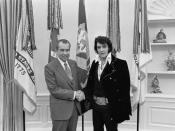America Kills Its Children" - Kent State Incident : May 4, 1970
Following Richard Nixon's annoucement on April 30 of the invasion of Cambodia and the need to draft 150,000 more soldiers for the Vietnam War effort, protesters started antiwar rallies at Kent State. On May 4. 1970, a group of National Guardsmen fired a volley of shots that killed 4 students and wounded 9 on the Campus of Kent State University in Ohio. It was the bloodiest incident in the history of campus conflict. It was also the most bitter, dividing the generations in their reactions. It's interesting to see first what was the political and social context of the time, and then to observe what really happened and what were the implications of this incident.
When Nixon became President in 1968, he promised to end the conflict in Vietnam: "I'm going to stop that war. Fast." The president promised the peace and the "vietnamization" of the conflict, i.e.
the withdrawal of the American forces and the transfer of the responsibility for the military operations to the South Vietnamese forces. However, the war was prolonged despite his initial promises. Nixon's strategy failed to disrupt the North vietnamese operations in Laos or Cambodia. The invasion and the instensifying of bombing of Cambodia prompted widespread denunciations at home as well as abroad, and provoked a wave of student demonstrations reminiscent of those in 1968.
The students who demonstrated were 'baby-boomers' mainly from the middle class. They had benefited from the economic prosperity, and questioned the comsumption habits of society, and the traditional values of America in a general climate of hostility against the Vietnam War. The intelectual movement prominent in the universities at these times was reflected by the New Left. The 'Students for a Democratic Society', SDS, were inspired by...


